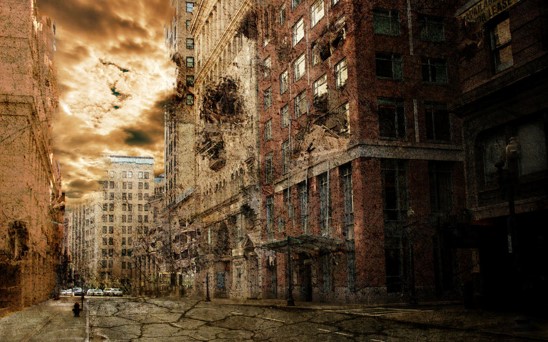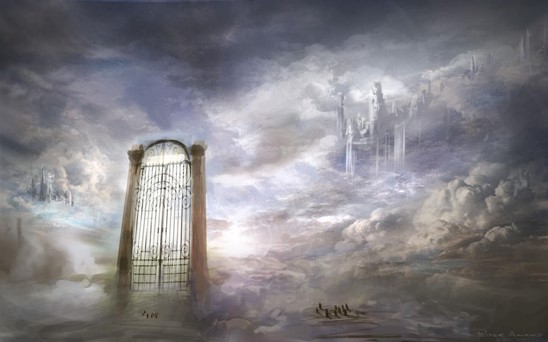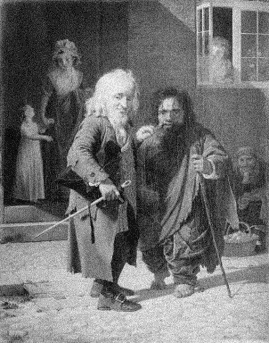Calling All Children C.S Lewis Says the Apocalypse is FOR YOU!
Have you read The Chronicles of Narnia? It may remind you of games you yourselves have made up. Away from adult eyes this world exists through a wardrobe, a painting, over a hill whenever it decides it needs you. Sound familiar? How many of you created worlds of your own[1] when you were out playing with friends or siblings? In the last book about the world he has created, C.S Lewis explains what happens when a world reaches its end. An apocalypse. Adults often use the word Apocalypse like some big scary end all be all of the whole world. Lewis is here to tell you that an apocalypse is just the start of something newer, something better. How many of us were dreaming up worlds with those descriptions, newer, better than what we are in right now[2]. This place is inviting to everyone and it is called Narnia. The last book in the Narnia series is called The Last Battle. What a title right? The battle to be the last of all time. Imagine a world with no more battles. That’s what Lewis is showing that an apocalypse will be the end of the suffering[3]. When we turn to the bible, we are also given comfort in 1 Corinthians 15-51 “Listen, I will tell you a mystery! We will not all die, but we will all be changed” and this is what Lewis shows in the last battle. He shows that there is a true world and that currently we are just living in “the shadowlands”. This new world is brighter shinier and bigger than the one we see now. It is a place where everyone we have ever loved is alive and well.
All Worlds Draw to an end; except Aslan’s Own Country -Zegrlinska p.1

[1] Many children of this time were left to their own devices especially out in the countryside. There wasn’t much to do except come up with it themselves. Laura Harrison interviewed many people from rural england in the early 20th century and she was told “entertainment in rural areas was sparse, except self-created jokes and fun” by a gentleman named Harry who was from glouchasire (Harrison p.1).
[2] When Lewis was writing these books there was a great feeling of dread in the surrounding world. While there was no more war rationing didn’t end until later the Bristol post remembers “In 1949, spivs were still very much in the news. Four years after the war had ended, rationing of most basic necessities and all luxuries persisted, and the black market was thriving.” (p.1). the children and their families were still living in war like times. The Cold war came right after the second world war and there was always imminent threat of nuclear war. Lewis himself was fearful and “by the early 1950s, moreover, his comments were taking on a more consciously fearful flavor.” (Walls p.335) even though he did not outright comment or condemn the atomic bomb.
[3] By showing that an apocalypse is just the start of something new it shows some of Lewis’s beliefs that. There have been notes from other authors saying that “Lewis believed that death was, for the redeemed, an entree into another (wonderful) world” (Walls p.337)
Coming up….. C.S
Lewis says the Apocalypse is for children
Seen on page Two!
Coming up…
There is no Heaven…. only more pg 3
Coming up….
Blind to Heaven.. Stuck in Hell
(or in this case a barn) pg 4
Lewis says the Apocalypse is For Children….
Recently Lewis published “The Last Battle” an ominous title for children. Even more so, is the content of the book. This book mirrors the biblical apocalypse in many aspects but such as most of Lewis’s writing he takes his own view on it.
Within The Last Battle, Lewis explains the end of the world for the world he created. Why would an author of children’s literature find the end of the world suitable content for a children’s book? Does Lewis believe that he is representing our world now or that since children are experiencing it that its ok for them to read about it? Yes!
He has explicitly stated this idea that children should not be exempt from these themes in literature. At a lecture he gave, “On Three Ways of Writing for Children” noted here by Kathrine Walls Lewis said “ ‘There is something ludicrous in the idea of [the censorship of violence in] so educating a generation which is born to the Ogpu [the Stalinist ancestor of the KGB] and the atomic bomb’ (39; emphasis added).” (Walls 336). This showed that Lewis was “defending the violent aspect of fairy tales (and, by implication, the warlike dimension of his own stories for children)” (Walls 336).
To kill off a world of your own creation must mean something big to a writer such as Lewis yet it seems to just follow natural events when you read the stories. Maybe he is trying to show that the world will end in a natural progression. The bible predicts that there will be flooding fires and eventually horns that blare the end of the world through blood and fire and the falling of stars from the sky (St Johns Revelations). Lewis, while believing in children’s stories that are still semi violent doesn’t think this story is good at describing an end to children. He is still a children’s author after all.


There is no Heaven… Only More
The promise of a world where everything is better where you will face no hardships, where everyone and everything you have ever lost is in one place. The idea of Heaven as presented by different authors, has been challenged and are continuously changed throughout the era, religion and civilization that the author lives in. The idea Lewis presents in “The Last Battle” is the idea that heaven is just what you know on a level that is seemingly better than the one you are currently experiencing. Aslan’s land is that of “heaven” and when the characters we have come to know and love “found themselves facing great golden gates” (p.219) there is a feeling of expectation where this is some magical land that is so much better than our own. Sort of how we have heightened the idea of heaven. When the children go through the gates, they do find themselves in the world they just left only somehow better.
“I have come home at last! This is my real country! I belong here. This is the land I have been looking for all my life though I never knew it till now. … Come Further up come further in!” -Jewl the Unicorn p.213
Once they are in this new world, they watch the end of the world they came to love. Narnia is engulfed by a darkness that at first the children think is just a cloud but is later realized “it was simply emptiness” (p.189). As the characters all move towards whatever center of this new world, they are trying to find they come to see that this is still the world they know and Lucy says “this is still Narnia and more real and more beautiful than the real Narnia down below” (p. 224). This echo’s ideas that Heaven is not new it is what is known just continuing forever. In Revelations 21 it is said “then I saw new heaven and new earth; for the first heaven and the first earth have passed away” and this mirrors what Lewis has done in the Last Battle. The idea of a New Earth in Revelations and a New Narnia in The Last Battle are so similar. Heaven is just new earth. “All of the old Narnia that mattered, all the dear creatures, have been drawn into the real Narnia through the Door” (p. 206) Death may seem final; an apocalypse may seem like the end of the world but Lewis is here to tell children that it is only the beginning of the next great adventure.
“and for us this is the end of all stories… But for them it was only the beginning of the real story.” P.228
Blind to Heaven Stuck in Hell…. (or in This Case a Barn!)
Satan’s realm, the underworld, the inferno, damnation whatever you would prefer to call it, hell is where you cannot be helped. In The Last Battle we see all the signs that humanity is slipping. The great Aslan has not been seen in so long there are animals who are starting to doubt his existence and his duty to them. One particular group the Dwarfs, is a story we can follow throughout this book as we watch them descend into non-believers. Faith in Aslan is not shown by the “dwarfs, who had become skeptical about Aslan, more isolated (“the Dwarfs are for the Dwarfs” [151, 153, 158]), obstinate, and materialistic as seen in their alliance with the exploiters of Narnia, the Calormenes. They represent people who are especially open to self-deception because they see with their eyes and not with their hearts” (Kohdam p.9). Seeing is believing is it not? Well, the dwarfs seem to think so. But whit if I were to tell you that what they refused to believe in could have been their salvation? The dwarfs are surrounded by the joyous things that the children are surrounded by yet they cannot see, hear or taste the same way the children can. The children ask Aslan to help them to see the truth and yet he replies “They will not let us help them they have chosen cunning instead of belief. Their prison is only in their own minds, yet they are in that prison; and so afraid of being taken in they can’t be taken out” (P.185-186 Aslan). The dwarfs were so afraid someone was going to come along and make them seem foolish that they refused to believe anyone or anything but themselves. We all know that that’s not what faith is. The bible tells us that “Now faith is being sure of what we hope for and certain of what we do not see.” Hebrews 11:1. The children all had faith in Aslan in their own stories even if there were times where they could not see him. The dwarves have lost their faith in Aslan they have lost their faith in the Narnian kings and queens, they see this as a chance for dwarfs to rule and to do good by the dwarfs. Yet in the end when everything comes to a close the dwarfs are stuck inside a shed unable to see in the dark. It is reminiscent of what Jacek Olesiejko wrote about hell saying it “is a place devoid of joy and festivity and closeness to Lord. The aforementioned nominal compound for Hell is thus depicted as physical construction having the form of a building” (Olesiejko p.156). This shows the entrapment of the dwarfs in the stable unable to free themselves because they have yet to free their minds. One dwarf makes it through because he always believed in Aslan however the rest of the dwarfs are blind to what is right in front of them. “Ain’t we all blind in the dark?” -Diggle the dwarf p.181


Works cited
Fisher, Jason, et al. C. S. Lewis and the Inklings: Discovering Hidden Truth. Cambridge Scholars Publishing, 2012. EBSCOhost, search-ebscohost-com.ezproxy.viu.ca/login.aspx?direct=true&AuthType=ip,cookie&db=nlebk&AN=539485&site=ehost-live
Harrison, Laura. “‘There Wasn’t All That Much to Do … at Least Not Here’: Memories of Growing up in Rural South-West England in the Early Twentieth Century.” Rural History, vol. 31, no. 2, 2020, pp. 165–180., https://doi.org/10.1017/s0956793320000199
Liljeroos, Laura. “‘You Must Learn to Know Me by That Name’: Case Studies of Representation of Biblical People and Events in C. S. Lewis’ The Chronicles of Narnia.” University of Turku, School of Languages and Translation Studies, 2021, pp. 1–56.
MGN ltd Publishers. “Summer of 1949 Rations, Radio and the War on Sundays: It’s the Time of Year When BT Gets All Nostalgic for the Golden (or Washed-out) Bristol Summers Past. In the Coming Weeks We’ll Be Looking at the Summers of 1959, ’69, ’79 and ’89. But First, Eugene Byrne Rolls up His Trouser-Legs, Loosens His Tie and Pulls a Knotted Hankie over His Head to Go Back to the Summer of 1949.” The Post, 30 July 2019, p. 2.
Olesiejko, Jacek. “Heaven, Hell and : The Presentation of the Universe in the Old English ” Studia Anglica Posnaniensia, vol.45, no.1, 2009, pp.153-162. https://doi.org/10.2478/v10121-009-0010-9
Walls, Katheryn. “When Curiosity Gets the Better of Us: The Atomic Bomb in The Magician’s Nephew .” Journal of the Fantastic in the Arts, Vol. 20, no. No. 3, 2009, pp. 334–349.
Wilhelmsson, Peter. “C.S. Lewis’ ‘The Chronicles of Narnia’: Towards a Definition of the Genre of the Christian Apocalypse.” Scholar Works, California State University, Northridge, 1 Jan. 1976, https://scholarworks.calstate.edu/concern/theses/v405sd696?locale=es.
Zegarlinska, M. “C.S. Lewis and the Apocalypse. the Eschatological Dimension of the Last Battle.” Academia.edu, https://www.academia.edu/6843095/C_S_Lewis_and_the_apocalypse_The_Eschatological_Dimension_of_The_Last_Battle.